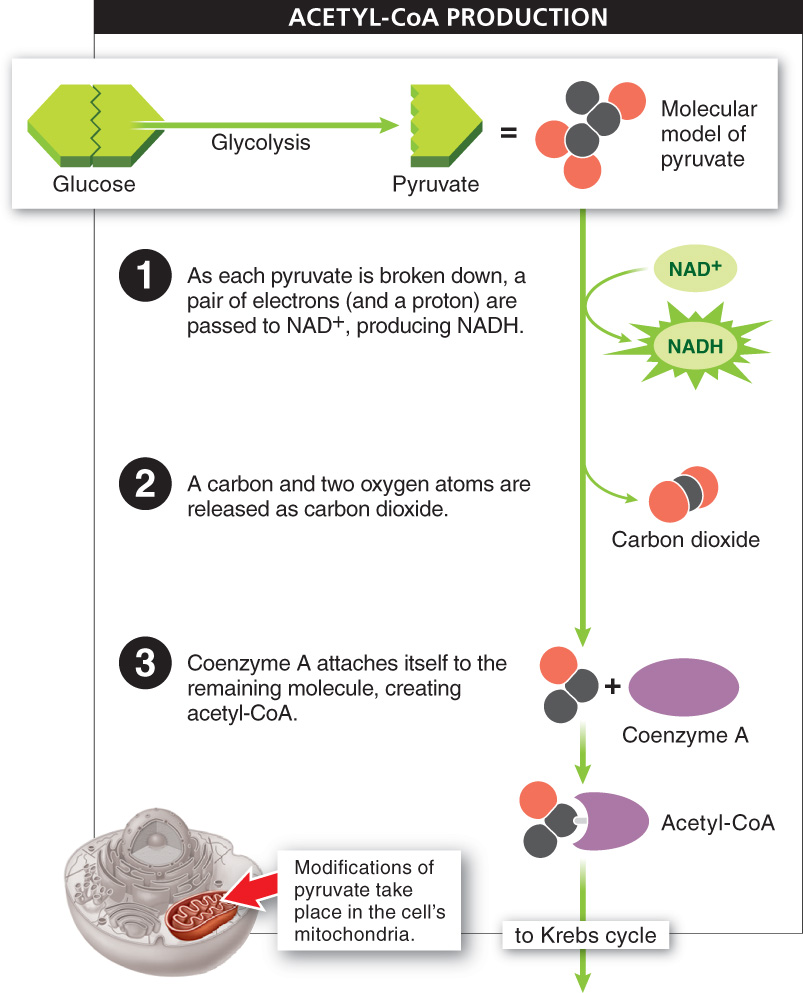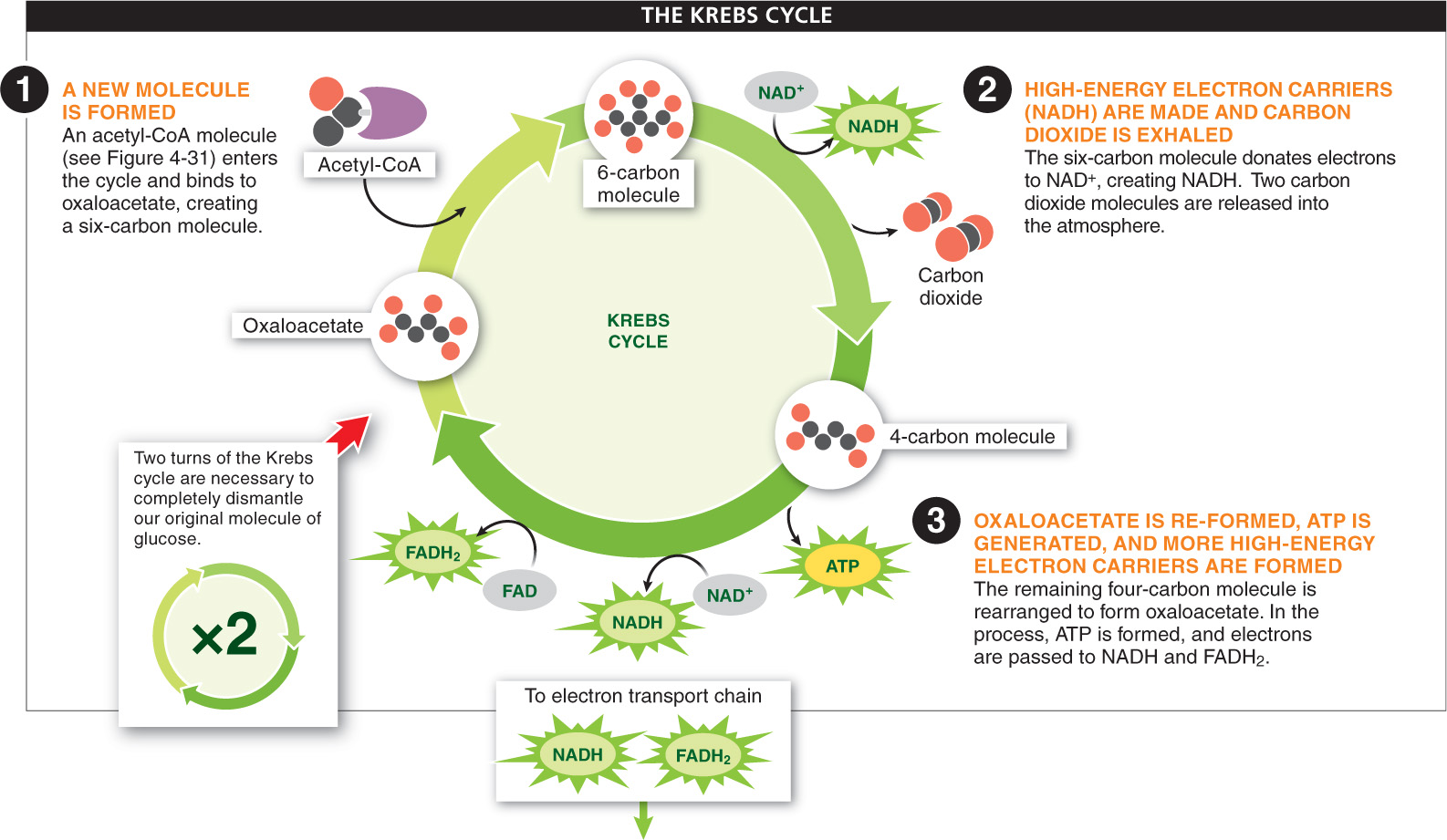Cells could stop extracting energy when glycolysis ends, but they rarely do so because that would be like leaving most of your meal on your plate. In glycolysis, only a small fraction of the energy stored in sugar molecules is recovered and converted to ATP and NADH. Cells get much more of an “energy bang” for their “food buck” in the steps following glycolysis, which occur in the mitochondria. This is why mitochondria are considered ATP “factories.” In the mitochondria, the molecules produced from the breakdown of glucose during glycolysis are broken down further, during two steps that are dramatically more efficient at capturing energy: the Krebs cycle (the subject of this section) and the electron transport chain (the subject of the next section). In breaking down the products of glycolysis, the Krebs cycle produces some additional molecules of ATP and, more importantly, captures a huge amount of chemical energy by producing high-
Aerobic training can cause our bodies to produce more mitochondria in cells. Why is this beneficial?
Before the Krebs cycle can begin, however, the end products of glycolysis—

Modification 1. Each pyruvate molecule passes a pair of its high-
Modification 2. Next, a carbon atom and two oxygen atoms are removed from each pyruvate molecule and released as carbon dioxide. The CO2 molecules diffuse out of the cell and, eventually, out of the organism. In humans, for example, these CO2 molecules pass into the bloodstream and are transported to the lungs, from which they are eventually exhaled.
Modification 3. In the final step in the preparation for the Krebs cycle, a giant compound known as coenzyme A attaches itself to the remains of each pyruvate molecule, producing two molecules called acetyl-
There are eight separate steps in the Krebs cycle, but our emphasis is on its three general outcomes (FIGURE 4-32).

Outcome 1. A new molecule is formed. Acetyl-
Outcome 2. High-
Outcome 3. The starting material of the Krebs cycle is re-
161
Now that we have seen the Krebs cycle in its entirety, let’s trace the path of the original six carbons in the original glucose molecule. In a sense, the carbon atoms that were first plucked from the atmosphere to make sugar during photosynthesis have been exhaled back into the atmosphere as six molecules of carbon dioxide.
- 1. Glycolysis: the six-
carbon starting point. Glucose is broken down into two molecules of pyruvate. No carbons are removed. - 2. Preparation for the Krebs cycle: two carbons are released. Two pyruvate molecules are modified to enter the Krebs cycle, and they each lose a carbon atom in the form of two molecules of carbon dioxide.
- 3. Krebs cycle: the last four carbons are released. A total of four carbon atoms enter the Krebs cycle in the form of two molecules of acetyl-
CoA, entering one at a time. For each turn of the Krebs cycle, two molecules of carbon dioxide are released. So the two final carbons are released into the atmosphere during the second turn of the wheel. Poof! The six carbon atoms that were originally present in our single molecule of glucose are no longer present.
So we’ve come full circle. In photosynthesis, carbon atoms from the air were used to build sugar molecules, which had energy stored in the bonds between their carbon, hydrogen, and oxygen atoms. In cellular respiration, the energy previously stored in the bonds of the sugar is converted to molecules of ATP, NADH, and FADH2. Carbon atoms from sugar are exhaled back into the air as CO2, and water is produced.
What happens to the high-
162
Why might the malfunctioning of mitochondria play a role in lethargy or fatigue?
As we explore the important roles of the Krebs cycle and electron transport chain in generating usable energy for organisms, it’s important to note that mitochondrial malfunctions have serious consequences for health. More than a hundred genetic mitochondrial disorders have been identified, all of which can lead to energy shortage, including muscle weakness, fatigue, and muscle pain. And, as noted in Section 3-
TAKE-HOME MESSAGE 4.14
A huge amount of additional energy can be harvested by cells after glycolysis. First, the end product of glycolysis, pyruvate, is chemically modified. Then, in the Krebs cycle, the modified pyruvate is broken down step by step. This breakdown releases carbon into the atmosphere (as CO2) as bonds are broken, and captures some of the released energy in two ATP molecules and numerous high-
What three types of energy-
During the Krebs cycle, in which the two pyruvate molecules formed during glycolysis are broken down into carbon dioxide, energy is captured and stored in the high-energy molecules ATP, NADH, and FADH2.